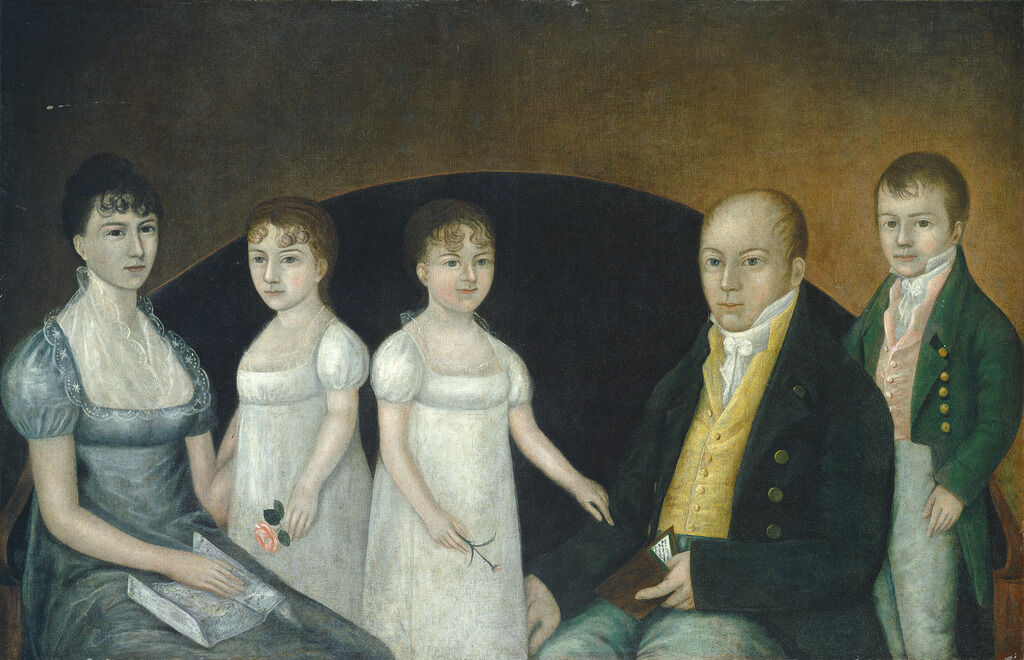The Mysterious Portraitist Joshua Johnson
Archives of American Art Journal
Volume 36, Number 2 (1996)
pages 2-7
Jennifer Bryan
Robert Torchia
The Maryland Historical Society’s Department of Manuscripts recently received three volumes of Baltimore County court chattel records—registers of personal property transactions such as mortgages, deeds of gift, powers of attorney, bills of sale, and releases of slaves from bondage. The earliest of the three volumes contains the bill of sale and the manumission record of America’s first-known black artist, the mysterious portraitist Joshua Johnson, who was active from 1790 to 1825. These extremely significant documents have survived through pure chance. According to the donor, M. Peter Moser. when the Baltimore City courthouse underwent renovation in 1954, many original documents were slated for destruction. His father. Judge Herman M. Moser, saw the discarded chattel records being thrown into bins and asked if he could have a few of the books, coincidentally saving the volume containing Johnson’s sale and manumission records.
Johnson’s existence was unknown until 1939, when Baltimore genealogist and an historian J. Hall Pleasants attributed thirteen paintings to him and attempted to reconstruct his career on the basis of fragmentary and often contradictory information. Pleasants characterized Johnson as a “nebulous figure” and he has remained so over the last fifty-eight years, despite numerous exhibitions and articles devoted to him. Only one of Johnson’s paintings bears his signature, Sarah Ogden Gustin (ca. 1805, National Gallery of Art, Washington. D.C.), and only one is documented in papers left by a patron, the well-known Rebecca Myring Everett and Her Children (1818, Maryland Historical Society, Baltimore). His life dates are unknown, and historians argue over whether his name was spelled Johnson or Johnston.
Even Johnson’s race has been a subject of contention. The idea that the artist was black was challenged when prices for his paintings escalated on the an market during the early 1970s. The authors of a history of African-American artists cast stronger doubts when they noted the highly circumstantial and speculative nature of the “evidence.”* Pleasants had collected four different accounts from the descendants of old Baltimore families who owned portraits by Johnson in which the artist was variously described as a slave, a slave trained as a blacksmith, a black servant afflicted with consumption, and an immigrant from the West Indies. In the federal censuses for Baltimore of 1790 and 1800, a Joshua Johnson is listed as a free white head of household. In the most comprehensive survey of Johnson’s life to date, Carolyn J. Weekley discovered an additional family tradition that held that Johnson was black and one that identified him as a “red man.” Until now, the sole documentary evidence that Joshua Johnson was indeed black was the Baltimore City Directory of 1817-1818, in which he is listed among “Free Householders of Colour.”
The issue of Johnson’s race has sociological and political ramifications. His gradual rise from anonymity to prominence paralleled the civil rights movement and, more recently, the academic emphasis on multiculturalism. Influenced by this climate, historians have tended to romanticize the artist, often at the expense of historical accuracy. Johnson has progressed from being parenthetically mentioned in a 1954 survey of American art as “a colored artist” who “remained a true primitive” to being the African-American artist par excellence.
The chattel records conclusively prove that Johnson was a mulatto, the son of a white man and a black slave woman owned by a William Wheeler. Sr. On July 15, 1782. the clerk of the Baltimore County court enrolled two documents, the bill of sale and the release from bondage of a slave named Joshua, “now aged upwards of Nineteen Years.” The bill records that on October 6…

